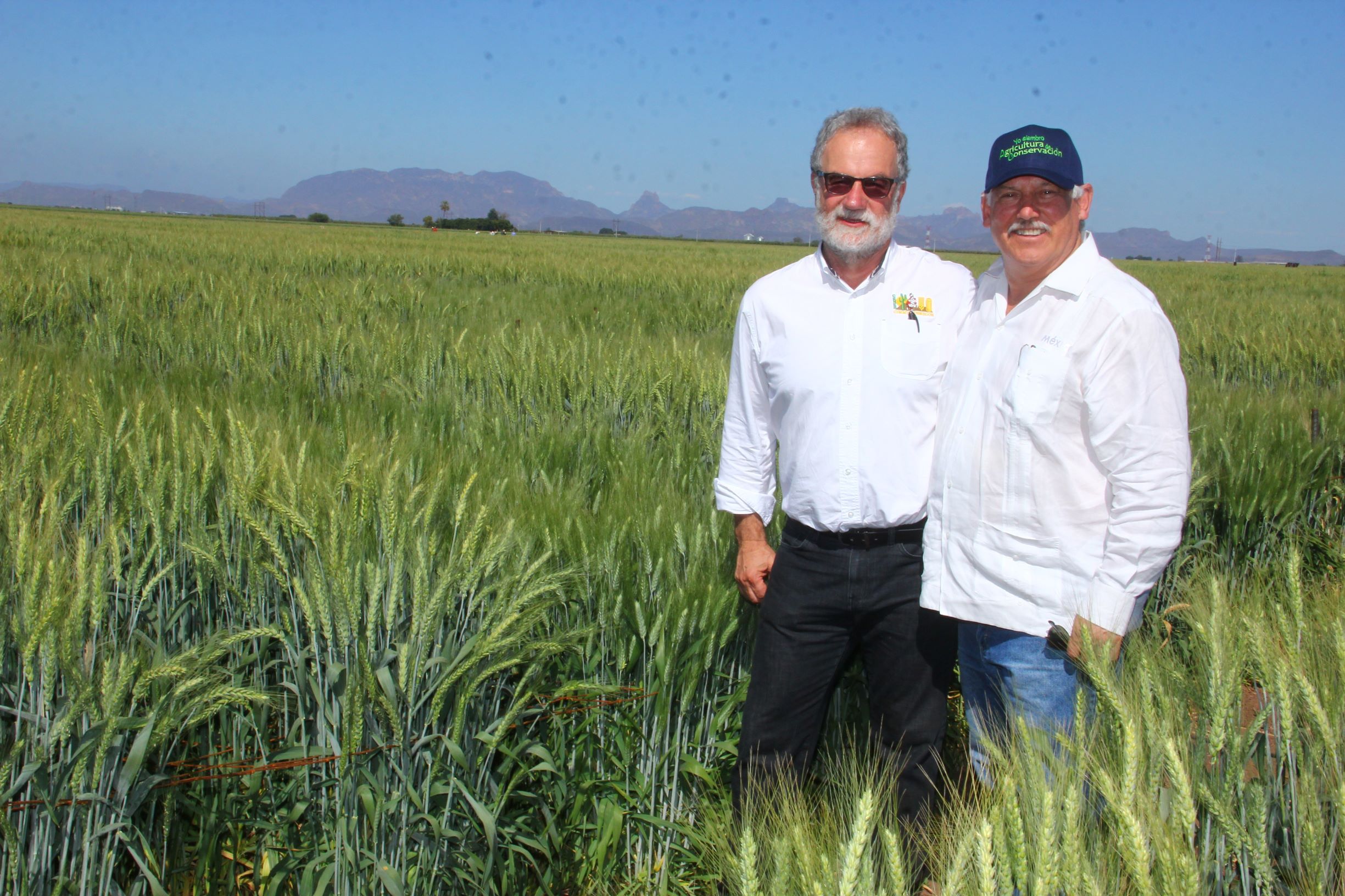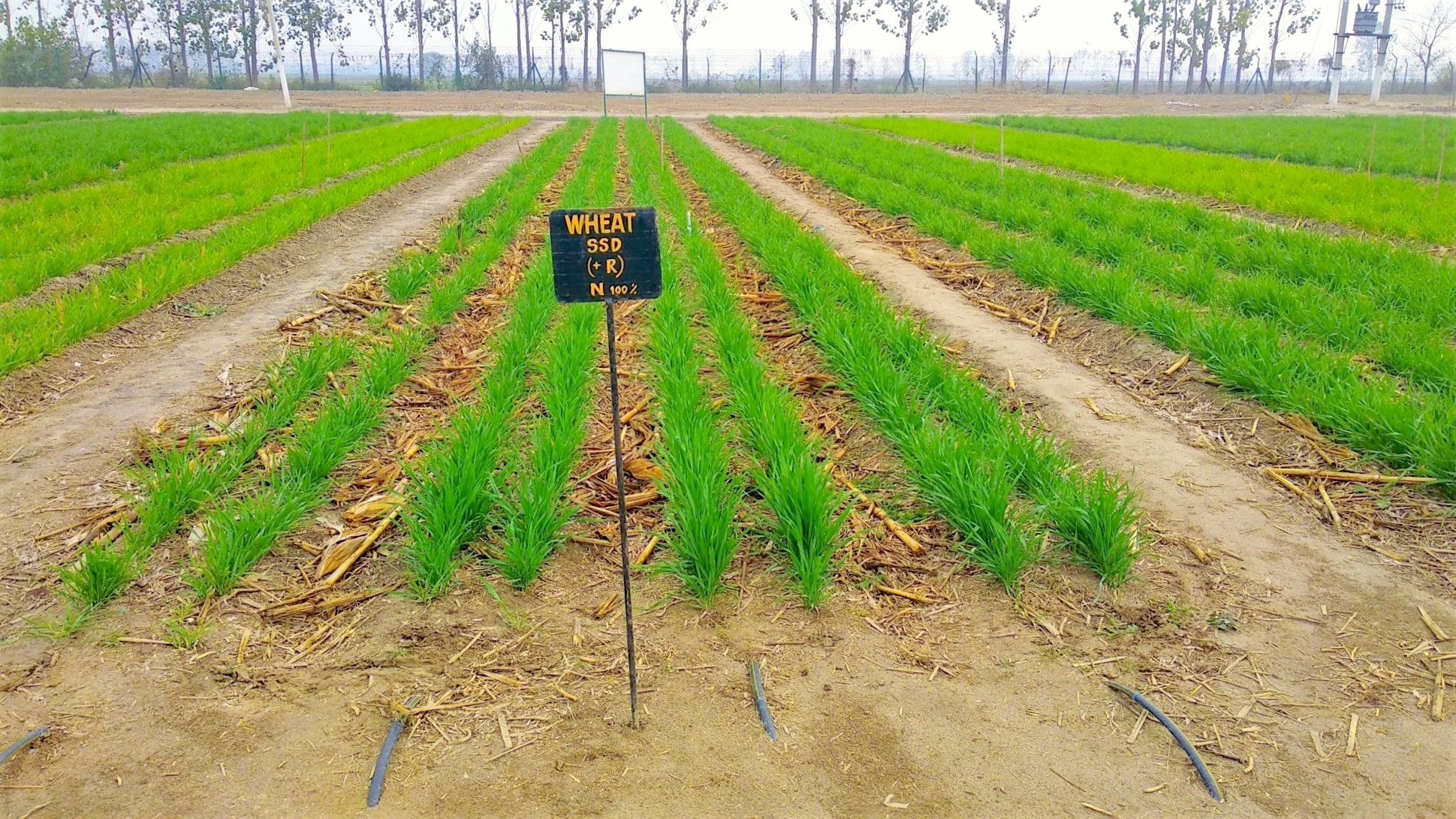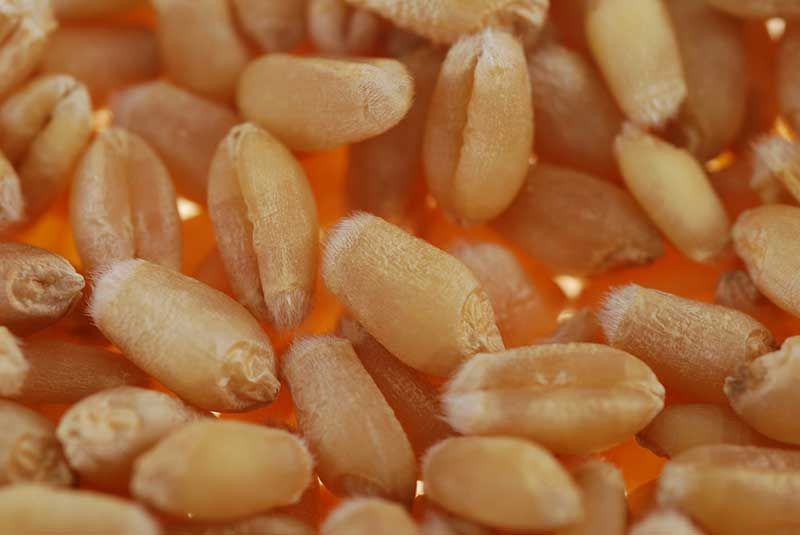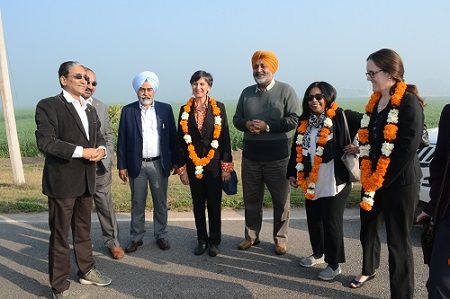funder_partner: Government of Punjab (India)
Mexican Secretary of Agriculture joins new partners and longtime collaborators in Obregon
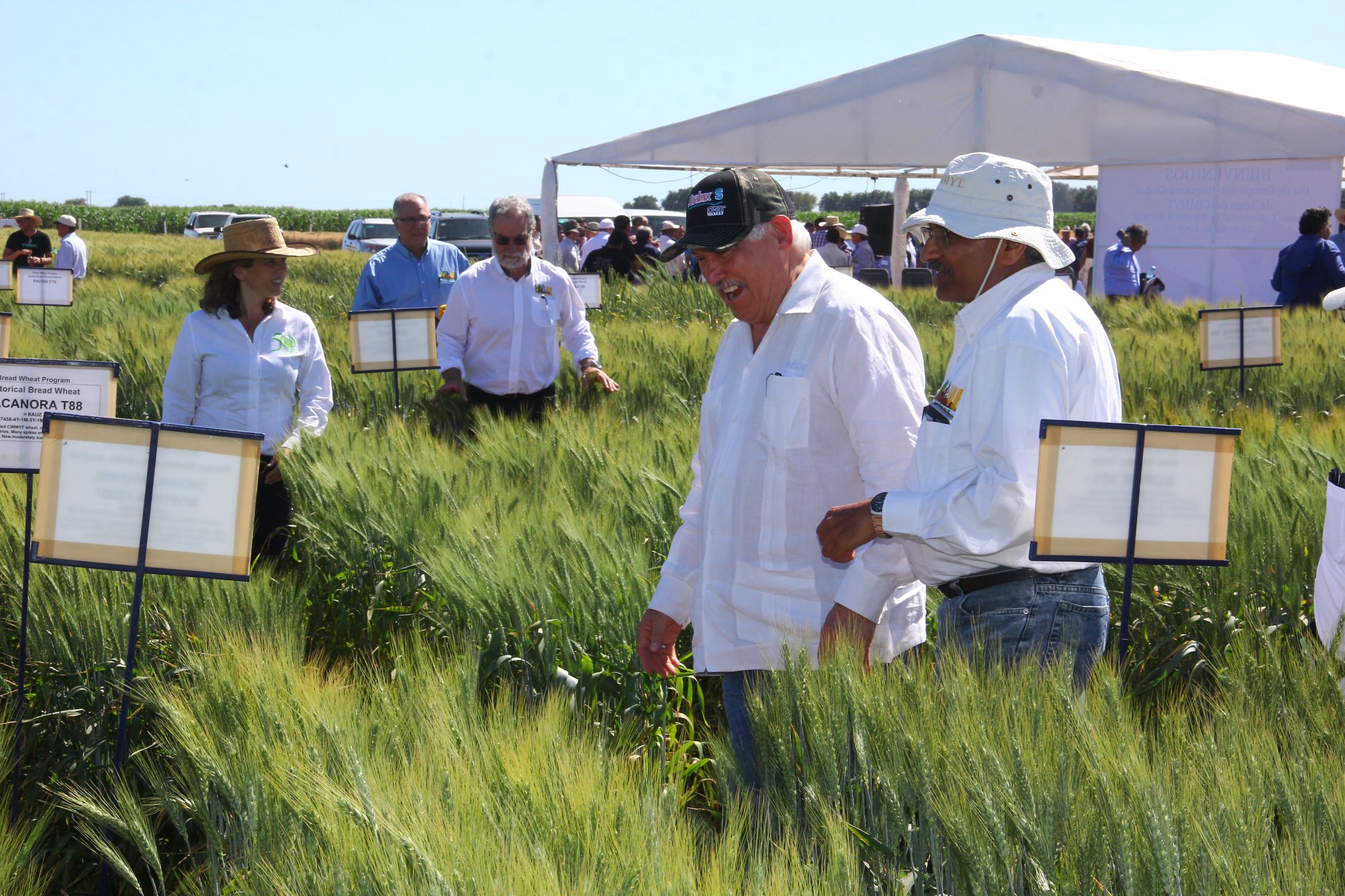
“The dream has become a reality.” These words by Victor Manuel Villalobos Arambula, Secretary of Agriculture and Rural Development of Mexico, summed up the sentiment felt among the attendees at the International Maize and Wheat Improvement Center (CIMMYT) Global Wheat Program Visitors’ Week in Ciudad Obregon, Sonora.
In support of the contributions to global and local agricultural programs, Villalobos spoke at the week’s field day, or “Dia de Campo,” in front of more than 200 CIMMYT staff and visitors hailing from more than 40 countries on March 20, 2019.
Villalobos recognized the immense work ahead in the realm of food security, but was optimistic that young scientists could carry on the legacy of Norman Borlaug by using the tools and lessons that he left behind. “It is important to multiply our efforts to be able to address and fulfill this tremendous demand on agriculture that we will face in the near future,” he stated.
The annual tour at the Campo Experimental Norman E. Borlaug allows the global wheat community to see new wheat varieties, learn about latest research findings, and hold meetings and discussions to collaborate on future research priorities.
Given the diversity of attendees and CIMMYT’s partnerships, it is no surprise that there were several high-level visits to the field day.
A high-level delegation from India, including Balwinder Singh Sidhu, commissioner of agriculture for the state of Punjab, AK Singh, deputy director general for agricultural extension at the Indian Council of Agricultural Research (ICAR), and AS Panwar, director of ICAR’s Indian Institute of Farming Systems Research, joined the tour and presentations. All are longtime CIMMYT collaborators on efforts to scale up and disseminate sustainable intensification and climate smart farming practices.
Panwar, who is working with CIMMYT and partners to develop typologies of Indian farming systems to more effectively promote climate smart practices, was particularly interested in the latest progress in biofortification.
“One of the main objectives of farming systems is to meet nutrition of the farming family. And these biofortified varieties can be integrated into farming systems,” he said.
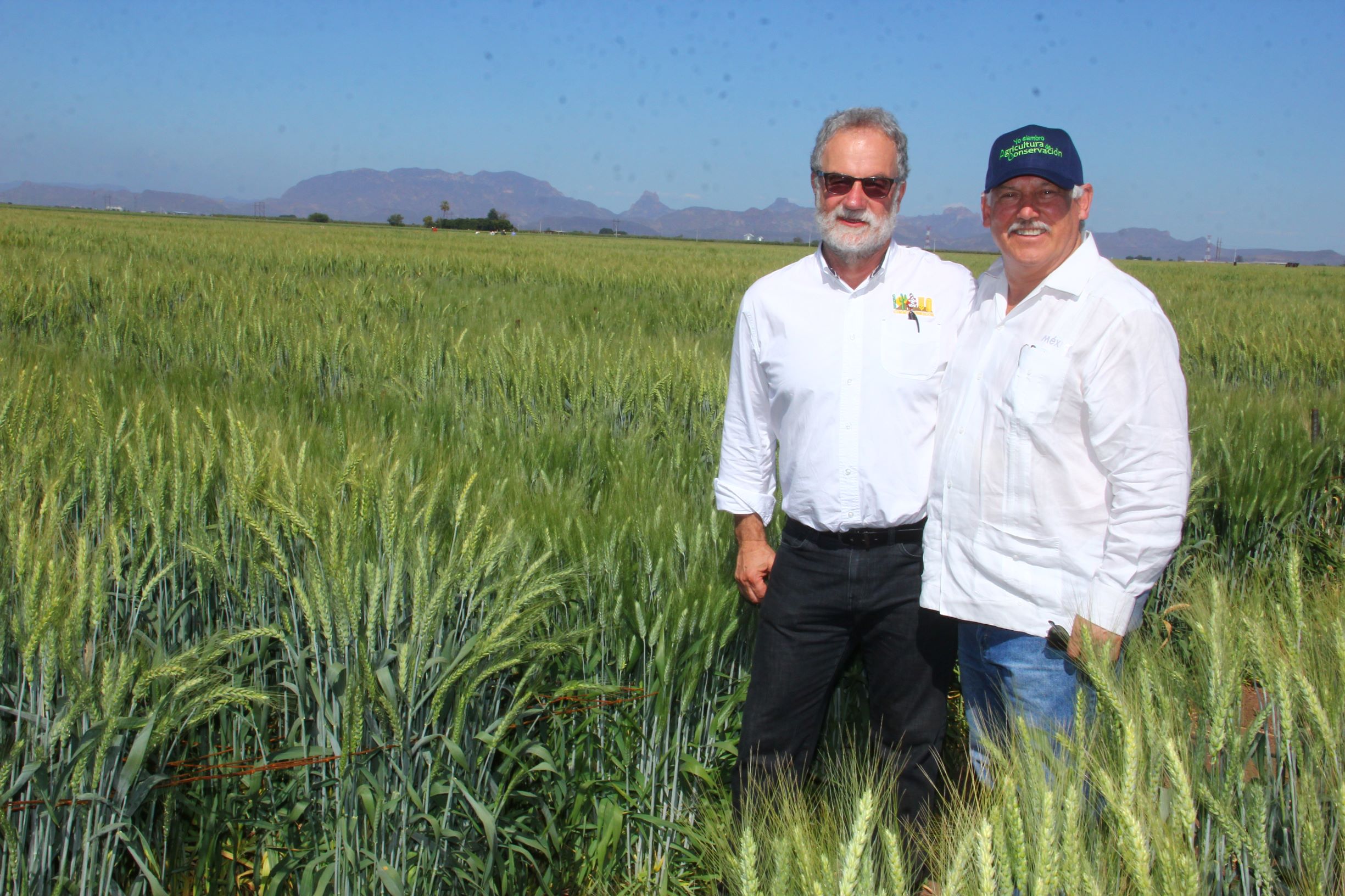
In addition, a delegation from Tunisia, including dignitaries from Tunisia’s National Institute of Field Crops (INGC), signed a memorandum of understanding with CIMMYT officials to promote cooperation in research and development through exchange visits, consultations and joint studies in areas of mutual interest such as the diversification of production systems. INGC, which conducts research and development, training and dissemination of innovation in field crops, is already a strong partner in the CGIAR Research Program on Wheat’s Precision Phenotyping Platform for Wheat Septoria leaf blight.
At the close of the field day, CIMMYT wheat scientist Carolina Rivera was honored as one of the six recipients of the annual Jeanie Borlaug Laube Women in Triticum (WIT) Early Career Award. The award offers professional development opportunities for women working in wheat. “Collectively, these scientists are emerging as leaders across the wheat community,” said Maricelis Acevedo, Associate Director for Science for Cornell University’s Delivering Genetic Gain in Wheat Project, who announced Rivera’s award.
CGIAR Research Program on Wheat and Global Wheat Program Director Hans Braun also took the opportunity to honor and thank three departing CIMMYT wheat scientists. Alexey Morgounov, Carlos Guzman and Mohammad Reza Jalal Kamali received Yaquis, or statues of a Yaqui Indian. The figure of the Yaqui Indian is a Sonoran symbol of beauty and the gifts of the natural world, and the highest recognition given by the Global Wheat Program.
The overarching thread that ran though the Visitor’s Week was that all were in attendance because of their desire to benefit the greater good through wheat science. As retired INIFAP director and Global Wheat Program Yaqui awardee Antonio Gándara said, recalling his parents’ guiding words, “Siempre, si puedes, hacer algo por los demas, porque es la mejor forma de hacer algo por ti. [Always, if you can, do something for others, because it’s the best way to do something for yourself].”
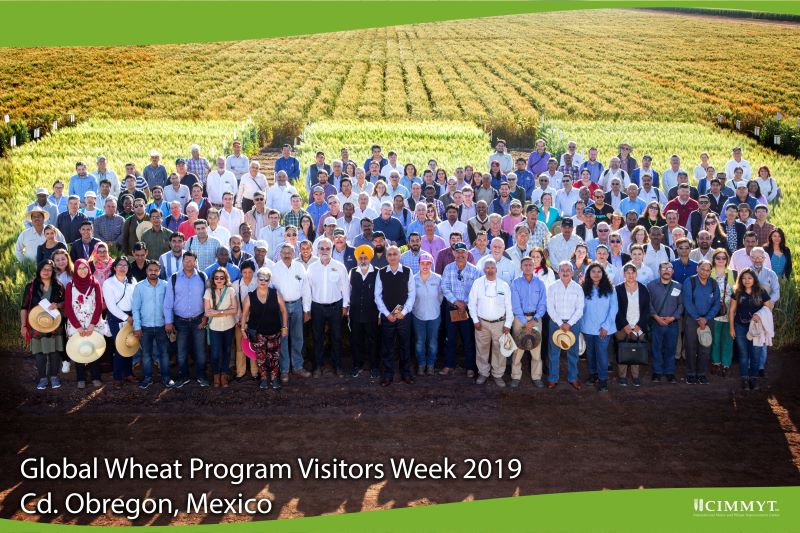
Innovative irrigation promises “more crop per drop” for India’s water-stressed cereals
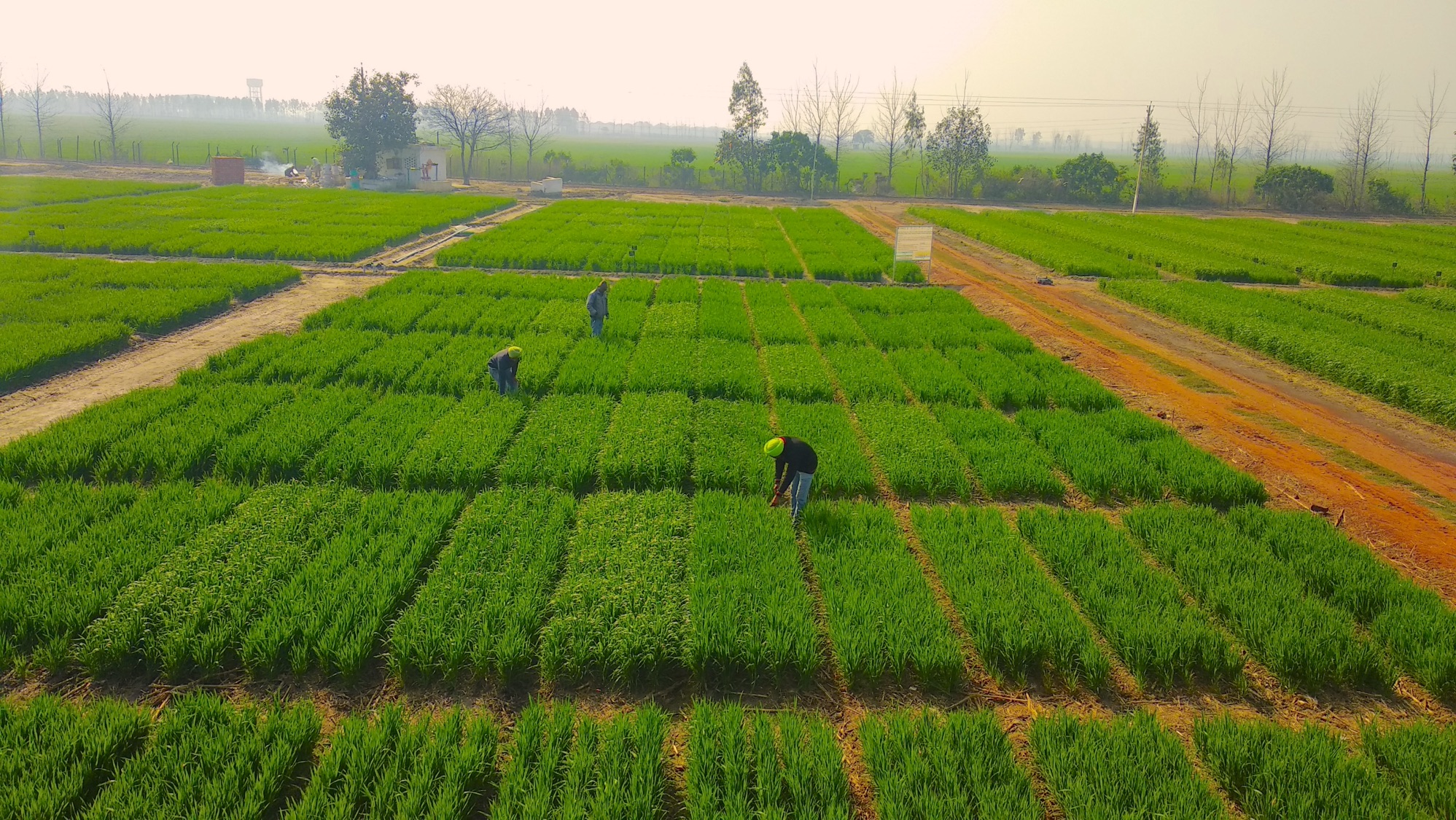
On World Water day, researchers show how India’s farmers can beat water shortages and grow rice and wheat with 40 percent less water
India’s northwest region is the most important production area for two staple cereals: rice and wheat. But a growing population and demand for food, inefficient flood-based irrigation, and climate change are putting enormous stress on the region’s groundwater supplies. Science has now confronted this challenge: a “breakthrough” study demonstrates how rice and wheat can be grown using 40 percent less water, through an innovative combination of existing irrigation and cropping techniques. The study’s authors, from the International Maize and Wheat Improvement Center (CIMMYT), the Borlaug Institute for South Asia (BISA), Punjab Agricultural University and Thapar University, claim farmers can grow similar or better yields than conventional growing methods, and still make a profit.
The researchers tested a range of existing solutions to determine the optimal mix of approaches that will help farmers save water and money. They found that rice and wheat grown using a “sub-surface drip fertigation system” combined with conservation agriculture approaches used at least 40 percent less water and needed 20 percent less Nitrogen-based fertilizer, for the same amount of yields under flood irrigation, and still be cost-effective for farmers. Sub-surface drip fertigation systems involve belowground pipes that deliver precise doses of water and fertilizer directly to the plant’s root zone, avoiding evaporation from the soil. The proposed system can work for both rice and wheat crops without the need to adjust pipes between rotations, saving money and labor. But a transition to more efficient approaches will require new policies and incentives, say the authors.
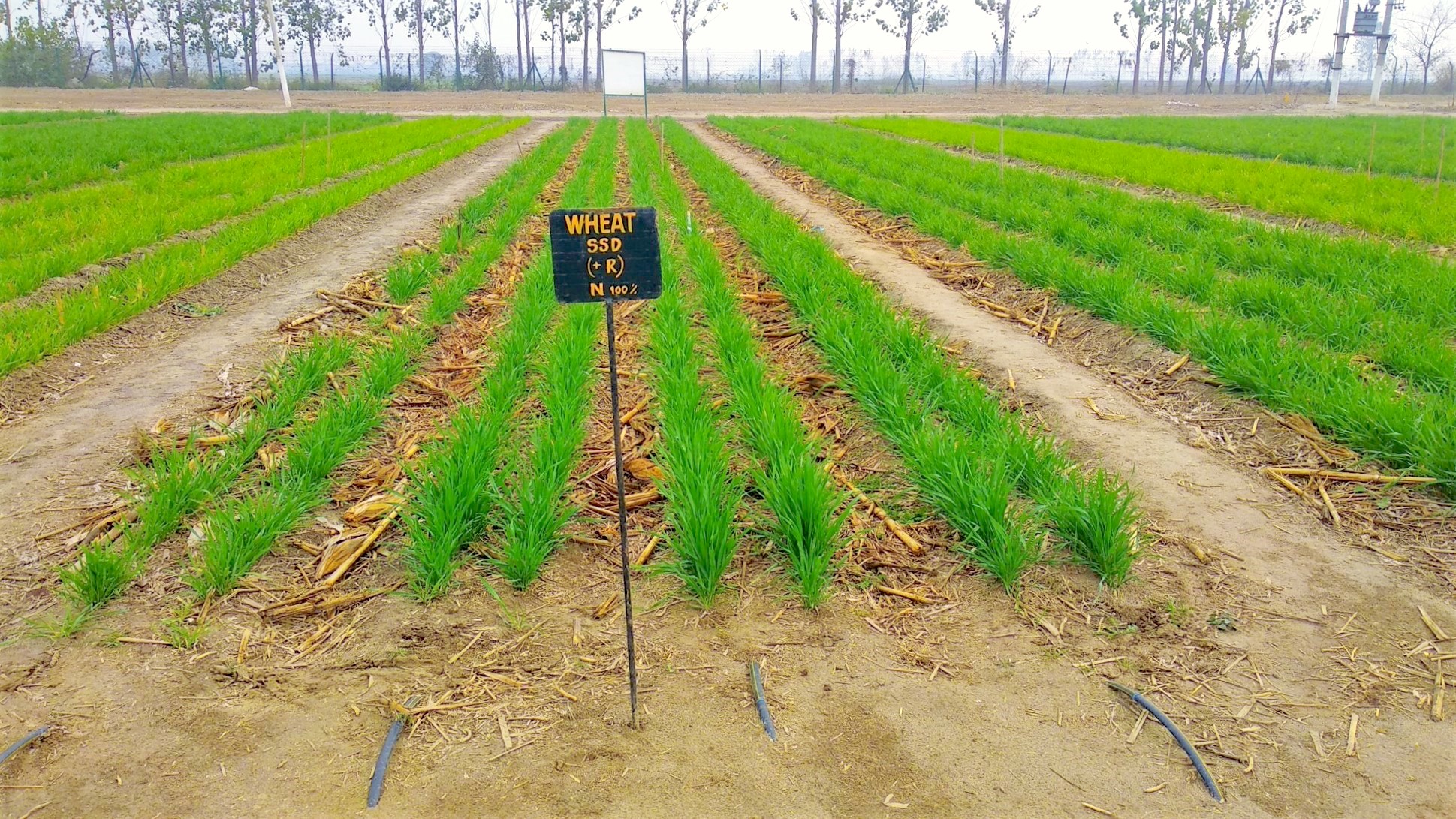
Read the full story:
Innovative irrigation system could future-proof India’s major cereals. Thomsom Reuters Foundation News, 20 March 2019.
Read the study:
Sidhu HS, Jat ML, Singh Y, Sidhu RK, Gupta N, Singh P, Singh P, Jat HS, Gerard B. 2019. Sub-surface drip fertigation with conservation agriculture in a rice-wheat system: A breakthrough for addressing water and nitrogen use efficiency. Agricultural Water Management. 216:1 (273-283). https://doi.org/10.1016/j.agwat.2019.02.019
The study received funding from the CGIAR Research Program on Wheat (WHEAT), the Indian Council of Agricultural Research (ICAR) and the Government of Punjab. The authors acknowledge the contributions of the field staff at BISA and CIMMYT based at Ludhiana, Punjab state.
New publications: Germplasm bank accessions add value to elite wheat lines
For the first time ever, a research team of more than 40 scientists has genetically characterized values of exotics in hexaploid wheat. CIMMYT scientists, together with partners in Demark, India, Mexico, Pakistan, and the UK, used next-generation sequencing and multi-environment phenotyping to study the contribution of exotic genomes to pre-breeding lines. Research required collaborative development, evaluation, and deployment of novel genetic resources to breeding programs addressing food security under climate change scenarios in India, Mexico, and Pakistan.
The team generated large-scale pre-breeding materials, which have been evaluated for important traits such as grain yield, quality, and disease resistance. Pre-breeding and haplotype-based approaches revealed useful genetic footprints of exotic lines in pre-breeding germplasm. Results of the study, recently published in Nature Scientific Reports, show that some DNA from exotic germplasm improved the biotic and abiotic stress tolerances of lines derived from crosses of exotics with CIMMYT’s best elite lines.
The practical successes of large-scale, impact-oriented breeding work will be useful to other wheat breeding programs around the world, and the information generated could be used to boost global wheat productivity.
Sukhwinder Singh, wheat lead on CIMMYT’s SeeD Project, explains that pre-breeding is in-demand and the resources developed through this study can serve as tools to address upcoming challenges in wheat production more efficiently, as desirable alleles from exotics have been mobilized into best elite genetic background. Breeding programs can now use this material to deliver outcomes in shorter timeframes by avoiding the lengthy process of searching for exotics first.
Read the full article in Nature Scientific Reports: “Harnessing genetic potential of wheat germplasm banks through impact-oriented-prebreeding for future food and nutritional security.”
This research was conducted as part of the Seeds of Discovery and MasAgro projects in collaboration with the Borlaug Institute for South Asia, and was made possible by generous support from Mexico’s Department of Agriculture, Livestock, Rural Development, Fisheries and Food (SAGARPA), the Government of Punjab, and the CGIAR Research Program on Wheat.
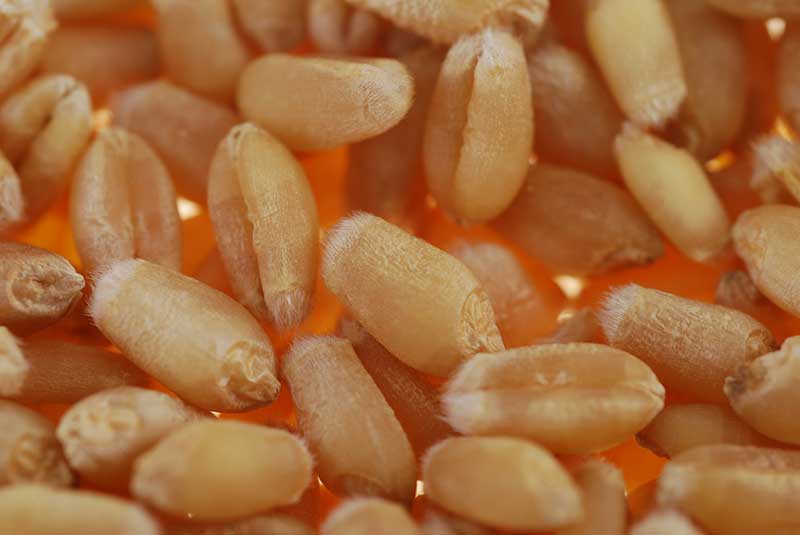
Check out other recent publications by CIMMYT researchers below:
- Applications of machine learning methods to genomic selection in breeding wheat for rust resistance. González-Camacho, J.M., Ornella, L., Perez-Rodriguez, P., Gianola, D., Dreisigacker, S., Crossa, J. In: Plant Genome v. 11, no. 2, art. 170104.
- Bayesian functional regression as an alternative statistical analysis of high‑throughput phenotyping data of modern agriculture. Montesinos-López, A., Montesinos-López, O.A., De los Campos, G., Crossa, J., Burgueño, J., Luna-Vázquez, F.J. In: Plant Methods v. 14, art. 46.
- Effect of ppd-a1 and ppd-b1 allelic variants on grain number and thousand-kernel weight of durum wheat and their impact on final grain yield. Arjona, J.M., Royo, C., Dreisigacker, S., Ammar, K., Villegas, D. In: Frontiers in Plant Science v. 9, art. 888.
- Genomic-enabled prediction accuracies increased by modeling genotype × environment interaction in durum wheat. Sukumaran, S., Jarquín, D., Crossa, J., Reynolds, M.P. In: Plant Genome v. 11, no. 2, art. 170112.
- Mexican tropical cream cheese yield using low-fat milk induced by trans-10, cis-12 conjugated linoleic acid: effect of palmitic acid. Granados-Rivera, L.D., Hernández-Mendo, O., Burgueño, J., Gonzalez-Munoz, S.S., Mendoza-Martinez, G.D., Mora-Flores, J.S., Arriaga-Jordan, C.M. In: CyTA-Journal of Food v. 16, no. 1, p. 311-315.
Innovations for cross-continent collaborations
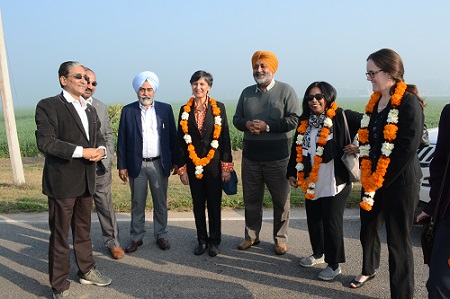
Australian High Commissioner to India, Harinder Sidhu, visited the Borlaug Institute for South Asia (BISA) in Ladhowal, Ludhiana, India on February 19.
Arun Joshi, Managing Director for BISA & CIMMYT in India, welcomed her with an introduction about the creation, mission and activities of BISA and the International Maize and Wheat Improvement Center (CIMMYT).
Sidhu also learned about the work CIMMYT and BISA do in conservation agriculture in collaboration with Punjab Agricultural University, machinery manufacturers and farmers. This work focuses on using and scaling the Happy Seeder, which enables direct seeding of wheat into heavy loads of rice residue without burning. This technology has been called “an agricultural solution to air pollution in South Asia,” as the burning of crop residue is a huge contributor to poor air quality in South Asia. Sidhu learned about recent improvements to the technology, such as the addition of a straw management system to add extra functionality, which has led to the large-scale adoption of the Happy Seeder.
The high commissioner showed keen interest in the Happy Seeder machine, and was highly impressed by the test-wheat-crop planted on 400 acres with the Happy Seeder.
Salwinder Atwal showed Sidhu the experiments using Happy Seeder for commercial seed production, and ML Jat, Principal Researcher at CIMMYT, presented on the innovative research BISA and CIMMYT are doing on precision water, nutrient and genotype management.
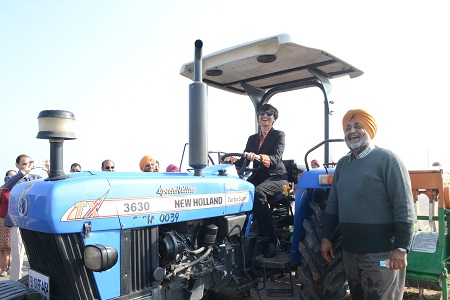
Sidhu visited fields with trials of climate resilient wheat as Joshi explained the importance and role of germplasm banks and new approaches such as use of genomic selection in wheat breeding in the modern agriculture to address the current challenges of climate change. He also explained the work CIMMYT does on hybrid wheat for increasing yield potential and breeding higher resistance against wheat rusts and other diseases.
ML Jat, who leads the CIMMYT-CCAFS climate smart agriculture project, explained the concept of climate smart villages and led Sidhu on a visit to the climate smart village of Noorpur Bet, which has been adopted under the CGIAR Research Program on Climate Change, Agriculture and Food Security.
During Sidhu’s visit to Noorpur Bet, a stakeholder consultation was organized on scaling happy seeder technology for promoting no-burning farming. In the stakeholder consultation, stakeholders shared experiences with happy seeder as well as other conservation agriculture amd climate smart agriculture technologies. BS Sidhu, Commissioner of Agriculture for the Government of Punjab chaired the stakeholder consultation and shared his experiences as well as Government of Punjab’s plans and policies for the farmers to promote happy seeder and other climate smart technologies.
“I am very impressed to see all these developments and enthusiasm of the farmers and other stakeholders for scaling conservation agriculture practices for sustaining the food bowl,” said Sidhu. She noted that Punjab and Australia have many things in common and could learn from each other’s experiences. Later she also visited the Punjab Agricultural University and had a meeting with the Vice Chancellor.
This visit and interaction was attended by more than 200 key stakeholders including officers from Govt. of Punjab, ICAR, PAU-KVKs, PACS, BISA- CIMMYT-CCAFS, manufacturers, farmers and custom operators of Happy Seeder.
The Borlaug Institute for South Asia (BISA) is a non-profit international research institute dedicated to food, nutrition and livelihood security as well as environmental rehabilitation in South Asia, which is home to more than 300 million undernourished people. BISA is a collaborative effort involving the International Maize and Wheat Improvement Center (CIMMYT) and the Indian Council for Agricultural Research (ICAR).

